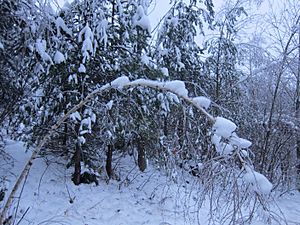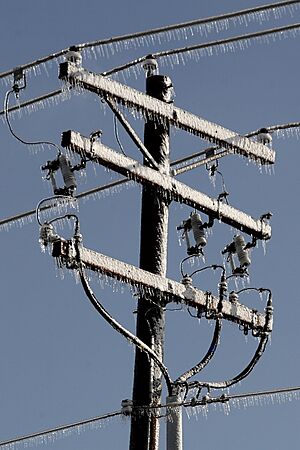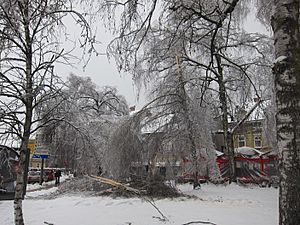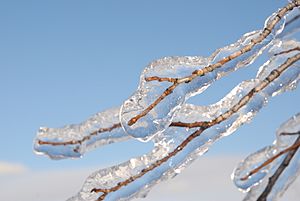Freezing rain facts for kids
Freezing rain is a type of rain that falls when the air near the ground is below freezing point (0°C or 32°F). Unlike sleet or hail, freezing rain starts as liquid water droplets. These raindrops get supercooled as they fall through a very cold layer of air. This means they are still liquid even though their temperature is below freezing. When these supercooled raindrops hit a surface, like the ground, trees, power lines, or cars, they instantly freeze.
The ice that forms from freezing rain is called glaze. This glaze can build up to be several centimeters thick, covering everything it touches. A big storm that creates a lot of glaze ice from freezing rain is often called an ice storm. Even though these storms aren't violent like a hurricane, freezing rain can cause many problems. It makes roads very slippery, breaks tree branches, and knocks down power lines because of the heavy ice. This can lead to widespread power outages and make it dangerous to be outside. Freezing rain is also very risky for airplanes because the ice can change the shape of their wings and controls.
What Freezing Rain Does
On the Ground
Freezing rain often causes big power outages. This happens when glaze ice builds up on things. If there's only a little freezing rain, the ice layer is thin. It might only cause small damage, like breaking off dead tree branches. But when a lot of ice builds up, it becomes one of the most dangerous winter weather events.
When the ice layer is thicker than about 0.25 inches (6.4 mm), tree branches can break. The weight of the ice makes them snap and fall onto power lines. Strong winds can make this damage even worse. Power lines covered in ice become very heavy. This can cause the poles, insulators, and lines themselves to break.
The ice that forms on roads makes driving very dangerous. Unlike snow, wet ice offers almost no grip for tires. Vehicles can slide easily, even on flat ground or gentle slopes. Because freezing rain hits the ground as liquid rain, it molds to the shape of whatever it lands on. This creates a thick, smooth layer of ice, which is why it's called "glaze."
Large-scale freezing rain and glaze are known as an ice storm. These storms can severely harm plants and trees. Trees may snap because they are dormant and fragile in winter. Pine trees are also easily damaged. Their needles catch the ice, but the trees cannot support the extra weight. For example, in February 1994, a severe ice storm caused over $1 billion in damage in the Southern United States. Another very bad ice storm hit eastern Canada and parts of New York and New England in 1998.

For Airplanes
Freezing rain is extremely dangerous for airplanes. It causes ice to build up very quickly on the aircraft's structure. Most helicopters and small planes do not have enough deicing equipment to fly in freezing rain. Even large airplanes with advanced deicing systems can be overwhelmed by heavy freezing rain.
While ice can make an aircraft heavier, this usually isn't the main problem. The biggest danger is that the ice changes the shape of the wings (called airfoils). This change reduces the aircraft's ability to lift and increases drag (resistance). Both of these issues make it harder for the plane to fly. They increase the speed at which the plane might stall and reduce its overall performance. This makes it very difficult for pilots to climb or even stay at the same altitude.
Pilots usually try to avoid freezing rain by flying into warmer air. Normally, this means flying lower. However, freezing rain often happens with a temperature inversion. This means the air actually gets warmer higher up. So, pilots would need to climb to find warmer air. This can be very difficult and risky, even with a small amount of ice on the plane.
For example, in 1994, American Eagle Flight 4184 faced heavy air traffic and bad weather. The flight was delayed from landing in Chicago. The plane, an ATR-72 with 68 people, entered a holding pattern about 65 miles (105 km) southeast of Chicago. As the plane circled, supercooled cloud droplets and freezing rain formed a ridge of ice on the top of its wings. This caused the autopilot to suddenly turn off, and the pilots lost control of the aircraft.
Related pages
Images for kids
-
The aftermath of freezing rain in Moscow Oblast, Russia, December 2010.
See also
 In Spanish: Lluvia engelante para niños
In Spanish: Lluvia engelante para niños








